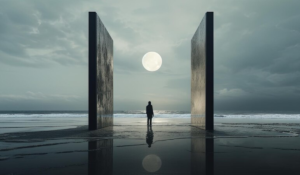Negative Space: How to Add Something with Nothing

Negative space is the art of transforming mundane images into captivating works of art in photography. But what is negative space, and how can photographers use it to enhance their compositions? This article examines negative space’s definition, versatility, and effective uses in photography.
Negative Space is defined as:

An empty space around and between the subjects in a composition that does not attract immediate attention is called negative space. As a result, the viewer’s eyes can rest and the main subject can be emphasized. To create balance and visual interest, this empty space is just as important as the main subject itself.
The versatility of negative space:
If used correctly, negative space can convey a variety of emotions, such as calmness, loneliness, or vastness. Additionally, it can add depth to a composition, add a sense of scale, or draw attention to a particular subject. Photographs using negative space can evoke specific moods and enhance storytelling, whether they are portraits, landscapes, or abstracts.
Portraits Using Negative Space:

Portraits can also effectively utilize negative space, contrary to popular belief. In order to guide the viewer’s eyes in a specific direction, photographers leave space around the subject’s gaze. A portrait’s negative space can convey intimacy or isolation, depending on the desired mood.
Artificially creating negative space:
A negative space can be added during post-processing as well as being captured on location. Utilizing tools like Content-Aware Fill, photographers can manipulate the composition to include negative space, altering the image’s visual impact. As a result of this flexibility, photographers are able to experiment with different compositions and refine their artistic vision.
Light/Shadow techniques such as shallow depth of field:

In busy scenes, shallow depth of field and playing with light and shadows can help create negative space. Photographers can emphasize empty space around a subject by blurring the background or exposing for specific areas. By utilizing these techniques, photographers are able to focus the viewer’s attention on their main subject and emphasize it effectively.
Subjectivity of Negative Space:

Negative space can sometimes become the main subject of an image when creatively composed. The empty space can draw the viewer’s attention and add visual interest to the composition when it forms unique shapes or patterns. The use of negative space by photographers can produce compelling and thought-provoking images that challenge viewers’ perceptions.
Frame Filling vs. Negative Space:

Negative space challenges the conventional wisdom that subjects should fill the frame in photography. Intentional empty space encourages photographers to create balance, evoke emotions, and enhance overall compositions. Photographers can create visually dynamic and engaging images by balancing positive and negative space.
The following are examples of negative space usage:

Negative space is effective in directing gazes, conveying mood, and creating visual interest in photographs, from minimalist landscapes to striking portraits. An image with negative space can elevate the impact of the image and leave a lasting impression on the viewer, whether it is a simple object against a blank backdrop or a lone figure against a vast sky.
In conclusion:
Using negative space effectively can transform ordinary photographs into visually compelling ones. A photographer can communicate emotions, guide the viewer’s eyes, and elevate the overall impact of their work by incorporating intentional empty space. Whether in photography or design, negative space adds depth, drama, and meaning to compositions.



